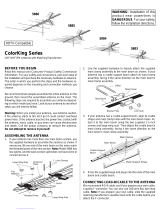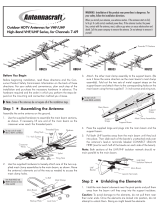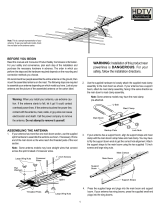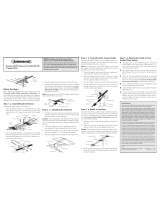Page is loading ...

©
1998, 2000 Tandy Corporation.
All Rights Reserved.
RadioShack is a registered trademark used by Tandy Corporation.
RadioShack.com is a trademark used by Tandy Corporation.
OWNER’S MANUAL — Please read before using this equipment.
VU-110XR VHF/UHF/FM Antenna with Matching Transformer
Your RadioShack VHF/UHF/FM Antenna performs better than
standard antennas because of its special design features.
UHF Bowtie — delivers more of the UHF signal to your TV.
Since UHF signals are more difficult to receive than VHF sig-
nals, this antenna gives UHF signals the extra boost they need.
VHF/UHF Isolation Network — prevents the two types of TV
signals from interfering with each other. This results in cleaner
signals and a better picture on your TV.
BEFORE YOU BEGIN
Before you begin installation, read this manual and the sepa-
rate Consumer Product Safety Commission information sheet.
For your safety and convenience, plan each step of the installa-
tion and purchase the necessary hardware in advance. The
hardware required and the order in which you perform the steps
depend on the mounting and connection method you choose.
Warning: When you install your antenna, use extreme caution.
If the antenna starts to fall, let it go! It could contact overhead
power lines. If the antenna touches the power line, contact with
the antenna, mast, cable, or guy wires can cause electrocution
and death. Call the power company to remove the antenna.
Do
not attempt to remove it yourself.
ASSEMBLING THE ANTENNA
Assemble the entire antenna on the ground.
1. Use the supplied hardware to loosely attach the supplied
mast clamp assembly to the main boom, as shown.
Note: To access the mast clamp holes, move the antenna’s
elements out of the way as needed.
2. Press the supplied large end plugs into the main boom.
3. Pull the UHF bowtie’s two halves away from the main boom
until they lock into place. Then slide each half’s unattached
end over one of the antenna’s lead-in terminals (one for
each half of the UHF bowtie on each side of the boom).
Note: Both sections of the UHF/VHF isolation network
should remain parallel to the main boom.
CONNECTING LEAD-IN CABLE
TO THE ANTENNA
We recommend RG-6 cable and, if you prepare your own ca-
ble, a quality F-connector. You can also use 300-ohm flat, twin-
lead cable. (RadioShack carries a variety of suitable cables and
connectors.)
Note: If you prepare your own coaxial cable, be sure to slide
the supplied matching transformer’s weather boot onto the ca-
ble before you attach the F-connector.
Using Coaxial Cable
To connect coaxial cable to your antenna:
1. Thread the supplied matching transformer’s spade termi-
nals through the antenna’s strain-relief tab.
2. Slide the spade terminals around the antenna’s lead-in ter-
minals (on both sides of the boom), then secure them with
the supplied flat washers and large wing nuts.
3. Screw the cable’s F-connector onto the matching trans-
former.
4. Slip the weather boot over the connection. If you use a
rebuilt cable without a weather boot, cover the connection
with weather-resistant tape.
U-Bolt
Mast Clamp
Backup Plate
Main Boom
Lock Nuts
UHF Bowtie Lead-In Terminal
UHF/VHF
Isolation Network
Lead-In Terminal
Weather Boot
F-Connector
Matching Transformer
Strain-Relief Tab
Flat Washers
Large Wing Nuts
Spade Terminal
Main
Boom
Lead-In Terminal
Spade Terminal
15-2153.fm Page 1 Wednesday, April 26, 2000 8:11 PM

2
Using Twin-Lead Cable
To connect flat, twin-lead cable to your antenna:
1. Split one end of the twin-lead cable for a length of about 3
inches. Then strip about
1
/
2
inch of insulation from both
leads.
2. Thread the stripped leads through the antenna’s strain-
relief tab.
3. Wrap each lead around one of the antenna’s lead-in termi-
nals (on both sides of the boom). Be sure there is enough
slack between the strain-relief tab and the antenna termi-
nals to prevent stress on the cable or the terminals.
4. Secure the leads with the supplied flat washers and large
wing nuts.
UNFOLDING THE ANTENNA’S ELEMENTS
1. Hold the main boom’s elements near the pivot points and
pull them away from the boom until they snap into the self-
locking plastic support insulators.
Caution:
To avoid damage to the elements, do not pull
them near their outer ends. Once the elements are locked
into position, do not attempt to unlock them. Doing so might
break the self-locking tabs.
2. Hold each wing boom and turn its elements until they snap
squarely into place (perpendicular to the boom).
3. Press the supplied small end plugs into the wing booms.
4. Bolt the triangular wing boom brackets onto the main boom
using the supplied 1
1
/
2
-inch screw and small wing nut, as
shown.
5. Insert the top and bottom wing booms into the wing boom
brackets. Secure them with the four supplied 1
1
/
4
-inch
screws and small wing nuts, as shown.
ATTACHING TO THE MAST
We recommend that you enlist the help of another person be-
fore you put up the mast or attach your antenna to it. How you
set up your mast depends on your specific installation. Refer to
the separate Consumer Product Safety Commission informa-
tion sheet for recommended methods.
1. Slide the antenna’s mast clamp assembly over the end of
the mast.
2. Tighten the mast clamp assembly’s lock nuts to hold the
antenna in place. Do not overtighten the lock nuts.
Caution:
The crossover wires must not touch the antenna
boom, the mast, or each other. If necessary, carefully bend
the crossover wires to provide at least
1
/
2
inch of clearance
between parts.
3. Set up the mast, then rotate it so the antenna’s shorter ele-
ments point toward the broadcast antennas of the stations
you want to receive.
Lead-In Terminal
Strain-Relief Tab
Twin-Lead Cable
Flat Washers
Large Wing Nuts
Main
Boom
Lead-In Terminal
Wing Boom
Brackets
Main Boom
1
1
/
2
-Inch
Screw
Small Wing Nut
Small Wing Nuts
1
1
/
4
-Inch
Screws
Top Wing Boom
Bottom Wing Boom
Wing Boom
Brackets
Crossover Wires
Mast
Toward TV
Stations’
Antennas
Main Boom Long Elements
Wing Boom Elements
Main Boom
Short Elements
15-2153.fm Page 2 Wednesday, April 26, 2000 8:11 PM

3
ROUTING THE CABLE TO YOUR
TV/VCR/FM RECEIVER
If you use coaxial cable:
• Use plastic tape or mast standoff insulators to secure the
coaxial cable to the mast at about 3-foot intervals. Continue
down the roof and the side of the house using roof and wall
standoff insulators.
• Use coaxial cable nail-in clips every few feet to secure the
cable between the mast and where the cable enters the
house.
• Use a 75-ohm grounding block at the point where the coax-
ial cable enters the house. Read the Consumer Product
Safety Commission sheet for grounding instructions.
• Use a wall-through lead-in tube (not supplied) to neatly
route the coaxial cable through walls.
If you use twin-lead cable:
• Be sure the twin-lead cable remains at least 4 inches away
from all metal surfaces.
• Use standoff insulators about every 4 feet. Twist the twin-
lead cable about three turns between standoff insulators.
• Read the separate Consumer Product Safety Commission
sheet for grounding instructions.
CONNECTING TO YOUR TV/VCR AND FM RECEIVER
Connect the antenna’s lead-in cable to your TV/VCR and FM receiver’s antenna terminals according to the type of cable you used.
RadioShack carries a variety of splitters. Choose one that best suits your needs. Below are some sample connections.
Make connections as shown if you have:
• Coaxial antenna lead-in
• Twin-lead UHF terminals
• Coaxial VHF terminal
• Twin-lead FM antenna terminals
Make connections as shown if you have:
• Coaxial antenna lead-in
• Twin-lead UHF terminals
• Twin-lead VHF terminals
• Twin-lead FM antenna terminals
Make connections as shown if you have:
• Coaxial antenna lead-in
• Combined coaxial VHF/UHF terminal
• Coaxial FM antenna terminal
RadioShack
Splitter with 75-Ohm Input
Cat. No. 15-1252
UHF
300 Ohm
VHF
75 Ohm
To FM
Receiver
Coaxial Lead-In
from Antenna
RadioShack
Transformer/Splitter
Cat. No. 15-1139
UHF
300 Ohm
VHF
300 Ohm
To FM
Receiver
Coaxial Lead-In
from Antenna
RadioShack
Hybrid Splitter/Combiner
Cat. No. 15-1141
TV
VHF/UHF
To
FM Receiver
Coaxial Lead-In
from Antenna
15-2153.fm Page 3 Wednesday, April 26, 2000 8:11 PM

15-2153
04/00
Printed in the USA
RadioShack
A Division of Tandy Corporation
Fort Worth, Texas 76102
Make connections as shown if you have:
• Twin-lead antenna lead-in
• Twin-lead UHF terminals
• Coaxial VHF terminal
• Twin-lead FM antenna terminals
RadioShack
Splitter with 300-Ohm Input
Cat. No. 15-1251
UHF
300 Ohm
VHF
75 Ohm
To FM
Receiver
Twin-Lead Lead-In
from Antenna
Limited Ninety-Day Warranty
This product is warranted by RadioShack against manufacturing defects in material and workman-
ship under normal use for ninety (90) days from the date of purchase from RadioShack company-
owned stores and authorized RadioShack franchisees and dealers. EXCEPT AS PROVIDED
HEREIN, RadioShack MAKES NO EXPRESS WARRANTIES AND ANY IMPLIED WARRANTIES,
INCLUDING THOSE OF MERCHANTABILITY AND FITNESS FOR A PARTICULAR PURPOSE,
ARE LIMITED IN DURATION TO THE DURATION OF THE WRITTEN LIMITED WARRANTIES
CONTAINED HEREIN. EXCEPT AS PROVIDED HEREIN, RadioShack SHALL HAVE NO LIABIL-
ITY OR RESPONSIBILITY TO CUSTOMER OR ANY OTHER PERSON OR ENTITY WITH RE-
SPECT TO ANY LIABILITY, LOSS OR DAMAGE CAUSED DIRECTLY OR INDIRECTLY BY USE
OR PERFORMANCE OF THE PRODUCT OR ARISING OUT OF ANY BREACH OF THIS WAR-
RANTY, INCLUDING, BUT NOT LIMITED TO, ANY DAMAGES RESULTING FROM INCONVE-
NIENCE, LOSS OF TIME, DATA, PROPERTY, REVENUE, OR PROFIT OR ANY INDIRECT,
SPECIAL, INCIDENTAL, OR CONSEQUENTIAL DAMAGES, EVEN IF RadioShack HAS BEEN AD-
VISED OF THE POSSIBILITY OF SUCH DAMAGES.
Some states do not allow limitations on how long an implied warranty lasts or the exclusion or limita-
tion of incidental or consequential damages, so the above limitations or exclusions may not apply to
you.
In the event of a product defect during the warranty period, take the product and the RadioShack
sales receipt as proof of purchase date to any RadioShack store. RadioShack will, at its option, un-
less otherwise provided by law: (a) correct the defect by product repair without charge for parts and
labor; (b) replace the product with one of the same or similar design; or (c) refund the purchase
price. All replaced parts and products, and products on which a refund is made, become the prop-
erty of RadioShack. New or reconditioned parts and products may be used in the performance of
warranty service. Repaired or replaced parts and products are warranted for the remainder of the
original warranty period. You will be charged for repair or replacement of the product made after the
expiration of the warranty period.
This warranty does not cover: (a) damage or failure caused by or attributable to acts of God, abuse,
accident, misuse, improper or abnormal usage, failure to follow instructions, improper installation or
maintenance, alteration, lightning or other incidence of excess voltage or current; (b) any repairs
other than those provided by a RadioShack Authorized Service Facility; (c) consumables such as
fuses or batteries; (d) cosmetic damage; (e) transportation, shipping or insurance costs; or (f) costs
of product removal, installation, set-up service adjustment or reinstallation.
This warranty gives you specific legal rights, and you may also have other rights which vary from
state to state.
RadioShack Customer Relations, 200 Taylor Street, 6th Floor, Fort Worth, TX 76102
We Service What We Sell
12/99
15-2153.fm Page 4 Wednesday, April 26, 2000 8:11 PM
/



